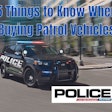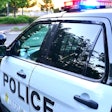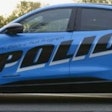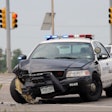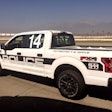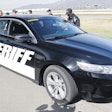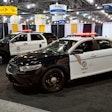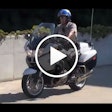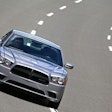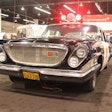There's a hard-and-fast rule in American business: Only a fool would try to start a new car company.
But if you talk to founding partners Stacy Dean Stephens and William Santana Li of Carbon Motors, they will tell you that their company will not join the long list of failed auto start-ups.
Only time will tell if Stephens, a former Dallas-area cop, and Li, a former Ford executive can really buck the history of automotive start-ups. But they would offer you this advice: "Don't bet against us."
POLICE Magazine's Editor David Griffith recently spoke with both men about the past, present, and future of Carbon Motors and the development of its E7 patrol car.
What brought you to the conclusion that law enforcement needed another patrol car?
Stacy Dean Stephens: In 1995 when GM made the announcement that it was shutting down the GM plant in Arlington, Texas, it sparked an idea for me. "Why don't they just retool specifically to cater to law enforcement?" That's really where it started.
Then when I became an officer, all of the things that I had thought about in 1995 and 96 to the time that I became an officer really started to make sense to me. I'd look at my car and think we could make so many improvements. It just made sense. And I was fortunate to come across the right guy at the right time to be able to put something together.
When you were on the job, what car did you drive?
SDS: I drove a Crown Victoria and I also drove a Tahoe.
Was there one thing in particular about these vehicles that reinforced your belief that officers need a purpose-built car?
SDS: There were two things actually: Safety and comfort.
I'm not a huge guy. But I can tell you that cramming yourself with all of your duty gear into the front seat of one of these vehicles for eight to 12 hours a day is just uncomfortable. The duty gear pushes in on your hips and on your kidneys and lower back and it's just not comfortable.
Then from a safety standpoint, I remember the first time that we got in the cars in the academy and those training cars didn't have the computer, didn't have the camera. They had a radio system and that was it. So when you get on the street and begin your FTO program and get in a fully equipped vehicle, it's a real shock. I remember the first time I got in one and I went, "Oh my God, how do we survive if we get into a crash?"
Also at the same time that I was thinking about this, we began seeing officers injured or killed because allegedly when their cars were hit from behind the collision was causing a thermal event.
How do you convince an automotive executive like Mr. Li that the world needs another car?
SDS: (Laughs) It took the right combination of e-mail and phone calls at the right time. I think if I had made the overture at any other time then this would have fallen on deaf airs. It just so happens that it was shortly after 9/11.
After 9/11 I sent him an e-mail. And he told me that he decided, "I need to respond to this guy. He's a first responder. We've just been attacked. I need to talk to him."
What's really funny now is that at the time he was thinking: This is never going to work. Ford has this locked up. There's no market here. This is a waste of time. But he's a very entrepreneurial guy, so he told me: "I'm not going to promise anything, but you've got 30 days to convince me."
Having known then what he knows now, he might not have made that suggestion. What he learned is that I'm pretty tenacious. I dug my heels in, and I supplied him with a wealth of information, and when he received it, he said, "We need to meet." And fortunately, we hit it off and we decided to go ahead and do something about it.
William Santana Li: Stacy called me and said, "We're literally dying out here. The major automakers won't give us a purpose-built car. Fire departments have their own purpose-built vehicles, so do the military, even garbage men, and mail men, but we don't have our own vehicle." In this day and age, that is no longer acceptable.
But, Mr. Stephens, you had no background in the automotive industry, right?
SDS: Zero. I think that actually helped me along the way. It's the naivete of not knowing that something cannot be done that has helped me to propel this into something that is actually being done.
So what is your role at Carbon other than spiritual advisor and former cop?
SDS: As you know, it takes a cop to talk to a cop, so sending a bunch of automotive guys out to have a conversation with a police officer doesn't work. That's because they don't understand. They've never done the job. They've never been on the side of the road with people driving by at 80 mph, and they've never had to fight and subdue somebody who is hopped up on PCP and get them into the back of a patrol car.
The risk with any small car company-and I don't mean that as an insult to you guys-but the risk with any boutique car company is that you might come out with a product that is so special, so expensive such as the Tesla that you can't sell it to anyone other than the very rich. So how do you avoid that?
SDS: We are both the manufacturer and the retailer. We don't have a dealer network of 4,400 dealers across the country that we have to support.
We also don't have to go out and buy a 30-second spot during the Super Bowl to try to sell police cars. The normal car company has maybe a $150 million to $300 million marketing budget. Mine is tens of millions of dollars because there are roughly 19,000-plus police agencies in the U.S., we know where all of them are, we know who runs them, and all we need to do is target our marketing to reach that audience. We don't have to go out and try to reach 150 million people.
From the production side, Our head of production spent 45 years doing nothing but smaller mid-volume markets. He knows better than anybody on the planet how to build a lower volume vehicle and do so profitably. So our production process is much more efficient.
You've got four major cost buckets in automotive production. You've got the big stamping facilities, the body shop where you take the stamped parts and weld them together, then the paint facility for the primer, and the paint, and the clear coat, and then the final assembly where workers put in the windshield and the interior.
Because we're doing exterior body panels in plastic, we don't need a stamping facility. Because we don't have hundreds of parts that need to be welded together, we only have tens of parts, we don't need that tremendously complex body shop. And with plastic panels, we have the ability to do an in-mold film that colors each panel, so now we don't need a paint facility. The thing that we're left with-and it's the most reasonable cost of the four-is the trim and final area. So our production process is a much leaner, efficient, and affordable way of producing a car, and that will help us get a vehicle out to law enforcement at a reasonable cost.
The first thing that anybody's going to ask about a plastic panel body is: Is it as safe as a conventional metal vehicle?
SDS: The plastic panels are actually not the structural component of the vehicle. The structural component is provided by the space frame. We have a skeletal aluminum structure that provides all of your cage, if you will, of the entire vehicle. Then the panels on the outside are plastic. And they are specifically there just to give it a skin.
The plastic panels are extremely durable. It's actually more durable than the metal body panels. Do you remember the Saturn commercial back in the '90s where they took a baseball bat and swung it into the side of the car. That's what we're talking about, that kind of rigidity.
For a police vehicle where you get tons of door dings and back into poles and things like that that immediately cause noticeable damage. We're talking about body panels that will bounce right back and you won't be able to notice the damage.
How are agencies going to get these cars serviced?
SDS: Most people are not aware of the number of service and maintenance facilities that are operated by law enforcement agencies and state, county, and municipal governments. Over 62 percent of law enforcement agencies have their own maintenance and service capabilities.
We'll provide the training. We'll get them completely certified to do all of the maintenance and warranty repair work so that they can work on their own vehicles.
So that obviously leaves another 40 percent of the market that we have to cover and, in those cases, we'll do a couple of different things. We'll offer a hub and spoke service approach.
Finally, if it falls outside of both of those, then we cannot launch into an area unless we can support it from a service standpoint. So until I get a backlog of orders that is large enough to support a Carbon-owned service center, we'll keep building a backlog in any given geographic area until we get a sufficient number of orders so that we can deliver the product and the service center all at once.
The model you've been showing has a really interesting sports car kind of look. But most concept car designs are changed quite a bit before production. Do you foresee that happening with your vehicle?
SDS: There will be slight changes. I think from what you see now to what it will be in production, it's going to be extremely close, probably 85 to 90 percent the same.
Mr. Li, what kinds of changes do you see in this vehicle between now and 2012? Is it going to look the same? Is it going to have the same features?
WSL: That's a fair question. One of the things that I so dearly love about this customer from a technical perspective is that law enforcement at large 95 percent of the conversation is very, very rational.
I call law enforcement officers "the binary customer." They are either "on" or "off." They want to know for example, will it stop 60 to 0 in this amount of feet, yes or no? Will the car go 0 to 60 in this amount of time, yes or no? It's not like the retail marketplace where you have this very fuzzy idea of the customer that you are going after. With this customer, it's plain as day as to what they want and they are very adamant about it. It's not every day that the target shifts.
So the vehicle we are showing is 80 to 90 percent of what it will be. There are a few things that we knew going in that were going to have to be changed, but it has the features that it does, not because we sat in a corner somewhere and decided, "Wow, this is kind of cool." It is the product of literally thousands of law enforcement officers saying this is what we need, this is what we want. Or this is the problem we are having, can you come up with a solution. It looks the way it does because law enforcement has its fingerprints all over it. So it is unlikely that there will be massive changes to the prototype by the time it hits production.
In other words, it looks cool, not just to look cool.
WSL: Well, remember I said that 95 percent of the conversation with law enforcement officers is rational, not 100 percent. Five percent of the conversation is not rational for various reasons. But its grounded in real concerns.
The look for example is about having a commanding presence. One of the first lines of defense for law enforcement is to have a commanding presence. For that reason, the vehicle needs to look tough and sporty and durable like it's all business. You are not going to put an officer in a pink minivan. That's just not going to happen.
What was your greatest design challenge?
WSL: It was very difficult to get it to look cool. And the reason why was that it had to accommodate big officers. The car if you look at its height, it is very tall. And to make a tall car look not quirky is very hard. It took a lot of tender-loving care to make sure that every single little line every single little character, everything on that vehicle forced the car to look lower than it is. It has a huge amount of headroom because one of the requirements from our customer was: "We have to be able to wear a hat and, if you're going to integrate the lights, they still need to be above most other vehicles so they can still see them."
That left us scratching our heads. "OK, the car needs to look really good and it needs to be tall." That was not an easy task but I think things came out alright.
Why did you choose a diesel engine?
SDS: There are a couple of answers to that question. If you go back to our concerns about officer safety and thermal events happening with existing vehicles, you'll see the safety benefits of diesel. Diesel fuel has a completely different thermal profile than gasoline. The flashpoint is much higher. It requires pressure in order to ignite. So a spillage of diesel vs. a spillage of gasoline is much safer. From a safety standpoint, that was key.
Additionally, if you look at Europe and Asia over 60 percent of the vehicles there run diesel. There's a reason for that. They have perfected it. It is a far more efficient fuel. The vehicles last much longer. And if you look at the usage profile of law enforcement, you have long periods of time sitting at idle then heavy acceleration and heavy breaking. Those are the times when diesel is most efficient at idle and under heavy acceleration because of the torque. All of those things helped us to make the decision along with a fuel economy of 40 percent improvement over anything in use today as a law enforcement vehicle. I think that said it all, and it helped us make that decision.
When do we expect to see these vehicles on the road?
SDS: Calendar year 2012.
Why will it take so long?
WSL: It takes some time to make sure that we deliver a world-class product that meets or exceeds all of the federally mandated safety standards for automobiles. meets a 75 mph rear impact without a thermal event. That requires a good amount of work. And we will put this entire vehicle through not only a comprehensive set of safety tests but also durability tests.
Most passenger vehicles are designed for 75,000, 100,000, 125,000 durability specifications because most consumers don't drive as many miles as law enforcement does. We're going to need to make sure that this vehicle has a 250,000-mile durability specification and that it will sit in Canada somewhere at minus 30 degrees for three days and then start. Then we're going to take it to Death Valley and make sure it's OK operating at 125 degrees or so. And then we'll take it to Europe and drive it at high speed on the Autobahn and make sure that the vehicle, not just the power train, but the body structure and the interior structure, can withstand the abuse that police vehicles go through.
When you ramp up and get everything running how many cars per year are you expecting to manufacture?
SDS: We are privately held so we won't be announcing our volume projections. Agencies purchase about 75,000 vehicles annually. And we will have capacity to meet that demand if there is that level of demand. At this stage we already have more than 1,000 agencies that have expressed an interest in purchasing the vehicles and that represents about 20 percent of the volume that is out there, even before we get to production. So we're easily going to be sold out the first year. Let's put it this way: We intend to get our fair share of the market.
How much of the patrol market do you think you'll have in 2020?
SDS: (Laughs) That is something that we do not publicly comment on. We'll let the vehicle speak for itself. Once agencies and officer get to using it and we prove ourselves, then we'll let the market speak.
I know I'm not going to nail you down on price.
SDS: The easiest way to state it is that we will be Competitive with a patrol-ready vehicle. So whatever the agency's definition of patrol-ready is, we'll be competitive with that. Obviously, different agencies equip their vehicles differently, and we have somewhere in the neighborhood of 80 options, that will determine the actual price of the vehicle. But we will be competitive with a patrol-ready vehicle.
You look back on all of the people who have tried to start new car companies, and a lot of people would tell you that you're crazy for attempting this. Why do you think you'll succeed when so many have failed?
SDS: (Laughs) We've got a stellar team. We have studied why others have failed and we know what their mistakes were and we know how to avoid them. And we have a very stable marketplace. If you ask any law enforcement officer, they will tell you that this is something we need. So it's not like we're trying to force feed them something that they don't necessarily need or could do without. They are clamoring for something, and that certainly makes it easier to talk to them about this.
Nonetheless, The world is really skeptical about small car companies because we have seen so many fail. What makes Carbon different?
WSL: To be very clear: We are a new Homeland Security company not a car company. We are not selling to the retail marketplace; we're not selling through a massive dealer infrastructure; we don't have organized labor and pension liability issues; we're taking these vehicles back at the end of their lives; and we are playing a big role on the service side after the sale. So we are more of a defense contractor than a car company.
Do you intend to sell the vehicle outside of the United States?
WSL: Yes. At IACP, you know the wonderful thing is the I in IACP, and the amount of interest from the Middle East to Russia, to Australia, to Asia, and Africa was abundant. Our priority is to sell it to the U.S. We need to take care of our domestic customers first, but think about how wonderful it would be from a macro perspective to be able to manufacture and export a durable good from the United States.






